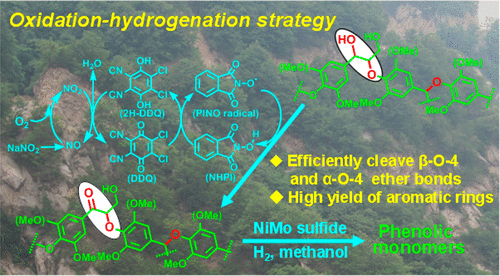当前位置:
X-MOL 学术
›
ACS Catal.
›
论文详情
Our official English website, www.x-mol.net, welcomes your
feedback! (Note: you will need to create a separate account there.)
Promoting Lignin Depolymerization and Restraining the Condensation via an Oxidation−Hydrogenation Strategy
ACS Catalysis ( IF 11.3 ) Pub Date : 2017-04-13 00:00:00 , DOI: 10.1021/acscatal.7b00148 Chaofeng Zhang 1 , Hongji Li 1, 2 , Jianmin Lu 1 , Xiaochen Zhang 1 , Katherine E. MacArthur 3 , Marc Heggen 3 , Feng Wang 1
ACS Catalysis ( IF 11.3 ) Pub Date : 2017-04-13 00:00:00 , DOI: 10.1021/acscatal.7b00148 Chaofeng Zhang 1 , Hongji Li 1, 2 , Jianmin Lu 1 , Xiaochen Zhang 1 , Katherine E. MacArthur 3 , Marc Heggen 3 , Feng Wang 1
Affiliation

|
For lignin valorization, simultaneously achieving the efficient cleavage of ether bonds and restraining the condensation of the formed fragments represents a challenge thus far. Herein, we report a two-step oxidation–hydrogenation strategy to achieve this goal. In the oxidation step, the O2/NaNO2/DDQ/NHPI system selectively oxidizes CαH–OH to Cα═O within the β-O-4 structure. In the subsequent hydrogenation step, the α-O-4 and the preoxidized β-O-4 structures are further hydrogenated over a NiMo sulfide catalyst, leading to the cleavage of Cβ–OPh and Cα–OPh bonds. Besides the transformation of lignin model compounds, the yield of phenolic monomers from birch wood is up to 32% by using this two-step strategy. The preoxidation of CαH–OH to Cα═O not only weakens the Cβ–OPh ether bond but also avoids the condensation reactions caused by the presence of Cα+ from dehydroxylation of CαH–OH. Furthermore, the NiMo sulfide prefers to catalyze the hydrogenative cleavage of the Cβ–OPh bond connecting with a Cα═O rather than catalyze the hydrogenation of Cα═O back to the original CαH–OH, which further ensures and utilizes the advantages of preoxidation.
中文翻译:

促进木质素解聚并通过氧化加氢策略抑制冷凝
对于木质素增价,同时实现醚键的有效裂解和抑制形成的片段的缩合是迄今为止的挑战。在此,我们报告了实现此目标的两步氧化-氢化策略。在氧化步骤中,O 2 /纳米2 / DDQ / NHPI系统选择性地氧化Ç α H-OH至C α = O的β-O-4结构内。在随后的加氢步骤中,将α-O-4和预氧化的β-O-4结构被进一步氢化在的NiMo硫化物催化剂,导致C的裂解β -OPh和C α–OPh债券。使用这种两步策略,除了可以转化木质素模型化合物外,桦木中酚类单体的收率也高达32%。C的预氧化α H-OH至C α = O不仅削弱的C β -OPh醚键而且避免了由于C的存在下进行缩合反应的α +选自C的脱羟基α H-OH。此外,硫化的NiMo倾向于催化C的hydrogenative裂解β -OPh键与C连接α = O,而不是催化C的氢化α = O回到原来的C α H-OH,这进一步确保了,并且利用预氧化的优点。
更新日期:2017-04-13
中文翻译:

促进木质素解聚并通过氧化加氢策略抑制冷凝
对于木质素增价,同时实现醚键的有效裂解和抑制形成的片段的缩合是迄今为止的挑战。在此,我们报告了实现此目标的两步氧化-氢化策略。在氧化步骤中,O 2 /纳米2 / DDQ / NHPI系统选择性地氧化Ç α H-OH至C α = O的β-O-4结构内。在随后的加氢步骤中,将α-O-4和预氧化的β-O-4结构被进一步氢化在的NiMo硫化物催化剂,导致C的裂解β -OPh和C α–OPh债券。使用这种两步策略,除了可以转化木质素模型化合物外,桦木中酚类单体的收率也高达32%。C的预氧化α H-OH至C α = O不仅削弱的C β -OPh醚键而且避免了由于C的存在下进行缩合反应的α +选自C的脱羟基α H-OH。此外,硫化的NiMo倾向于催化C的hydrogenative裂解β -OPh键与C连接α = O,而不是催化C的氢化α = O回到原来的C α H-OH,这进一步确保了,并且利用预氧化的优点。































 京公网安备 11010802027423号
京公网安备 11010802027423号